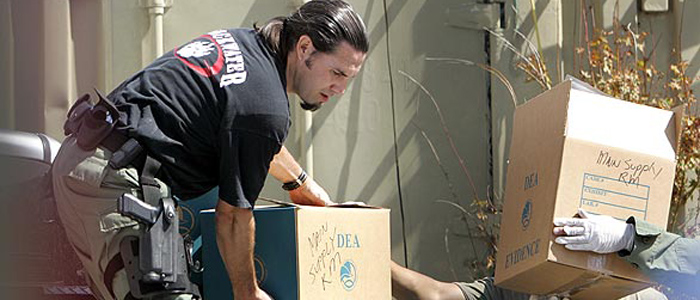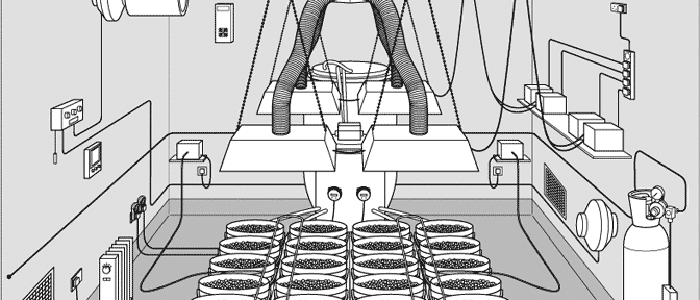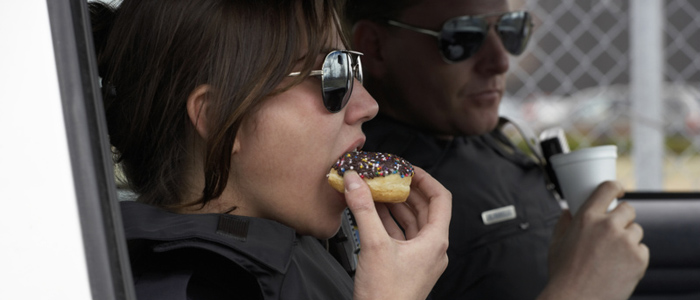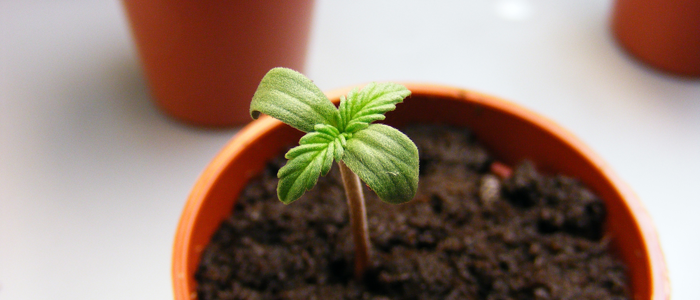Now that we know how and where to buy our marijuana growing supplies, it’s time to get some…
Marijuana Growing Education
There are three main phases to growing any plant – germination/seedling, vegetation, and flower. I’ll get to harvesting, drying and curing at the end. I’ll also add a bit about perpetual growing which is really the second best part of growing. The absolute best part of growing is, of course, smoking your hard work.
Marijuana’s time schedule depends heavily on the strain and the grower. Overall the time can be anywhere from 2.5 months to 6 months. Indica strains are usually faster growing than sativa strains by about 4 weeks. Hydroponics is faster than soil by about 2-4 weeks. I can rattle off a million examples but it doesn’t matter. You’ve got to find your perfect strain and perfect growing method. It’s al up to the grower.
Lighting, air, and nutrients are important issues. Remember, we are trying to mimic nature.
During germination, the seed will need complete darkness and a warm place as if it were in the earth during Spring when this warm up.
During the seedling and vegetation phases, the plant will need a lot of light to mimic those Spring/Summer days and plenty of nutrients. This is why you’ll need a light timer because you can’t expect to be there to turn the lights on and off appropriately. You can set your timer to 18 hours of light and 6 hours of dark. Some growers use 24 hours of light straight. You’ll stay in the vegetation phase for as long as you like, typically 2-4 weeks.
Flowering occurs when the normal day/night cycle is about even – during the later summer through the fall finishing in the early winter – 12 hours of light and 12 hours of dark. You’ll be in flower from as little as 4 weeks to 12 weeks depending on the seeds you have.
Germination/Seedling
This phase simply covers the first week or so from seed breaking out of its shell to sprouting a taproot up to the first set of true leaves. This will all happen in the first 7 to 10 days. There are many ways to germinate a seed. Personally, I like the tissue paper method.
- Wet some tissue with warm water
- Fold about 5 to 10 seeds in that tissue
- Place the tissue in a plastic bag or baggie
- Leave it a dark and warm place
- Wait 24-48 hours for the seeds to pop
- When you see about a 0.25 inch of taproot, place it in your media (dirt or rockwool)
You’ll come across other methods online, many are good. I’ve tried them all and don’t think there are any that don’t work.
The seed will provide enough nutrients for the plant to grow in this phase. They will look like bean sprouts at first. After you’ve planted them, you’ll see the top of the sprout, open up with these rounded leaves and green up within a few hours. You’ve given birth to a seedling. YAY, but it ain’t over! As the grower, simply water the seedling and let it “eat” its own resources. The plant will use this time to grow its roots into that complex web you may see weeks or months later. You’ll know the plant is ready for feeding when you see the first set of true leaves. Proceed with a very light nutrient solution, 10% of the recommended dose.
The germination phase will take place over a 2 to 3 day period. The seedling phase will happen over the next 4-5 days.
Vegetation
The seedling phase is pretty much over when you start feeding or when the cotyledons start withering. This is when the plant will begin to show vigorous growth. You can start feeding your marijuana and just let it grow. Remember to mimic nature – plenty of light and air.
If you’re in soil, make sure air is flowing through because those roots need to breathe. That means do not overwater or else your roots will be sitting in mud. The roots will use up all available oxygen after which they will suffocate. So, make sure to have set up good drainage.
If you’re in hydroponic solution, make sure your air stone, tubing, and air pump are all working together to keep that water full of air for the roots to use. And, make sure your hydroponic solution is healthy. Don’t be afraid to change out the water and so on.
At the end of vegetation we come to flowering. You’ll reach the end of vegetation when you want. A marijuana plant can stay in vegetation for long time. Since, flowering is dependent on you, flip your light timers to “12 hours of light and 12 hours of dark” aka 12/12. Now, you’re in flower.
Flower
This is where all the fun begins. You’ll spend another week or two as the plant transitions into flowering. Growth hasn’t stopped, it’s just changing tracks, so to speak.
Instead of building more roots and leaves, it’s going to start getting prepared to procreate – pistils and pollen. You will be able to tell a female marijuana plant by its pistils, sometimes referred to as the “hairs”. They’ll be white and coming out of a sort of tiny pouch called a calyx. The pistil catches the pollen which then slides into the calyx. The seed process begins and the calyx is the “womb” for that seed. They’re small but visible. On the other hand, the male will start showing pollen sacks aka “balls” because they hold “plant sperm” and they’re kind of round. Get rid of the males. Remember, they have no THC. We want to concentrate on the females.
At this point, you want to just let the plant keep doing what it’s doing. Keep the top layer and root zone healthy and the plant itself properly fed.
The females will start to grow buds which is just a collection of calyxes with pistils. The fun part starts when those buds and the surrounding leaves start producing THC in what are called trichomes which look like tiny poles with a ball on top. They are much easier to see with a microscope which I hope you’ve purchased from the list of items to get. You’ll be relying on it in a minute.
Harvest, Dry, and Cure
You can tell when the marijuana is ready to be harvested by looking at the color of the trichomes. At this point, it’s all about the trichomes. Trichomes start off clear. As the plant matures, they become cloudy and eventually turn amber or yellowish-brown. You want to harvest around when most of the trichomes in a sample have turn mostly cloudy with a touch of amber.
There are benefits to pulling a plant earlier than later. Without getting into the different sciences that apply, pulling marijuana a little early may benefit those looking for a “head high”. Pulling marijuana a little late may benefit those looking for more of a body high. However, don’t full assume this is how you get the difference between a head high and body high. The real difference is in the type of marijuana you are growing but pulling a little early or late does help depending on what you want.
Once you’re happy with your plant’s progress, cut her down. You have to prepare the plant for drying. Mold is your enemy here. Mold likes warm and humid places. Stagnant air only helps their process even more. There are many methods to drying but hanging them upside-down in a cool, dark, dry, airy place does the trick. Depending on how much marijuana you have, this may take weeks. But, we’re growing personal and if you don’t have too many plants, it may only take a few days.
Pull a sample bud from your plant. Record the weight. I hope you bought your scale. You’ll know when you’re plant is dry when that bud’s weight is about 20% of the original weight. It will go down quickly. You don’t want it to go down too fast however, too slow may bring problems. Just remember to keep air flowing and the area dry. You may want to check your buds from time to time just to make sure they’re ok.
After you’ve reached that all important dry weight, this is where you want to cure your marijuana. Curing is not necessary to smoke the marijuana. Once it’s dried properly, it’s smokeable. Curing is important because it brings out the taste and flavor of marijuana. Curing has other benefits as well. You cure by keeping your marijuana in large containers. Whatever moisture is left in the buds will become equally distributed throughout the plant matter, drying out some parts and rehydrating others. You don’t want completely dry marijuana. It will be like dust and harsh to smoke. A little moisture is good for a smoother smoking session.
Perpetual Growing
Perpetual growing is simply a way to grow marijuana in its different phases, concurrently. Remember the processes that marijuana goes through – seedling, vegetation, flower, and harvest. While one plant will experience all of these processes in order, this does not mean that all of your plants have to go through it at the same time.
Let’s “walkthrough” a typical grow period of 4 months or 16 weeks.
- Week 1: Germination/Seeding
- Weeks 2-6: Vegetation
- Weeks 7-14: Flower
- Weeks 15-16: Harvesting/Drying/Curing
To run perpetually, look at the longest grow period which is the flowering for 7 weeks. You could be germinating and vegging plants in that time period since it’s only 5 weeks. So, when you move your first set to flower, you’ve got 2 weeks to rest and start a new set of seeds. At the end of the flowering time for the first set, you can immediately move the second set into to flower. You’ve just shaved 5 weeks off the initial 4 months. You can’t rush flower but you can start a third set in another 2 weeks.
It’s easier to view the process on a calendar
- 01/01: Germination/Seedling
- 01/08 – 02/05: Vegetation
- 02/06 – 03/19: Flower
- 02/20 – 02/27: Germination/Seedling of 2nd set
- 02/27 – 03/20: Vegetaion of 2nd set
- 03/19 – 04/02: Harvesting/Dry/Cure
- 03/21 – 05/09: Flower of 2nd set
- 05/09 – 05/23: Harvest/Dry/Cure of 2nd set
As we can see, the time between the harvests of the first and second sets of crops is less than 2 months (April 2 to May 23) as opposed to 4 months if we started the cycle again from Week 1. If we continue to run the veg, flower, and harvest at basically the same time, the next set of crops will be ready to smoke by July 13th and again by September 3rd. In this way, a grower can literally pull 5-6 crops every year as opposed to 3 crops the regular way (April, August, December).
The initial comment is simply comparing the addiction potential between alcohol and marijuana. The person, Woodcut, seems to be someone who understands addiction because he admits to his own 15-year long alcoholism. I would go so far as to consider him an authority on addiction. This is someone you can take their word over others. He also uses marijuana which is not addictive. His comparison would have any intelligent individual conclude that alcohol, a freely available substance, is more addictive than marijuana.
What’s so hard to understand about that?







